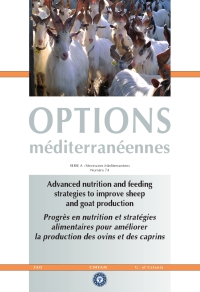| Article précédent | p. 257-261 | Article suivant |
Influence of fibrolytic enzymes on in vitro methane production and rumen fermentation of a substrate containing 60% of grass hay
Batch cultures of mixed rumen microorganisms were used to study the effects of exogenous fibrolytic enzymes on the in vitro fermentation of a substrate composed by a 60:40 mixture of grass hay and concentrate. Three enzymatic preparations were tested: cellulase from Aspergillus niger (CEL), xylanase from Trichoderma viride (XYL), and a 1:1 mixture cellulase:xylanase (MIX). Samples of substrate (500 mg dry matter (DM)) were accurately weighed into 120-ml serum bottles and enzymes were added directly into the bottles at three levels: 0 (control; CON), 15 (-15) and 30 (-30) IU/g substrate DM. Bottles were kept at room temperature for 24 h before incubation with buffered rumen fluid. All enzymatic treatments, with the exception of CEL-15, increased (P<0.05) CH4 production after 6 h of incubation, but after 24 h of incubation differences (P<0.05) with control were only detected for XYL-15, XYL-30 and MIX-30. Acetate, propionate and butyrate productions at both 6 and 24 h of incubation were increased (P<0.05) by all enzymatic treatments. NH3-N concentrations, pH and gas production at 24 h of incubation were not affected (P>0.05) by the addition of enzymes. The treatment of substrate with XYL-15, MIX-15 and MIX-30 increased (P<0.05) neutral-detergent fibre degradability (61.3, 59.9 and 60.6%, respectively) compared to the control (56.5%). The results indicate that the xylanase was more effective than the cellulase in stimulating the in vitro fermentation of substrate, but for most of the measured parameters there were no differences (P>0.05) due to the level of enzymes (15 vs 30 IU/g DM).
Les effets des enzymes fibrolytiques exogènes sur la fermentation d'une ration composée d'herbe et concentré (60:40) ont été étudiés en utilisant une technique in vitro de type batch . Les trois préparations enzymatiques étaient une cellulase d'Aspergillus niger (CEL), une xylanase de Trichoderma viride (XYL) et un mélange 1:1: des deux (MIX). Des échantillons de la ration (500 mg matière sèche (MS)) ont été traités avec des préparations enzymatiques à trois doses : 0 (témoin ; CON), 15 (-15) et 30 (-30) UI/g MS, pendant 24 h à température ambiante, puis mis en suspension dans un milieu anaérobie, inoculé avec du contenu de rumen, et incubés à 39°C. La production de CH4 après 6 h d'incubation a augmenté (P<0,05) avec tous les traitements enzymatiques, sauf avec CEL-15, tandis qu'après 24 h on n'a eu de différences qu'entre XYL-15, XYL-30, MIX-30 et le témoin. Les productions d'acétate, propionate et butyrate après 6 et 24 h d'incubation ont été plus importantes (P<0,05) avec les traitements enzymatiques qu'avec le témoin, mais aucune différence significative n'a été notée entre les traitements pour les concentrations en azote ammoniacal ou pour le gaz produit. Le traitement de la ration avec XYL-15, MIX-15 et MIX-30 a augmenté (P<0,05) la dégradabilité de la fibre (61,3, 59,9 et 60,6%, respectivement) par rapport au témoin (56,5%). Ces résultats montrent que la xylanase a été plus effective pour stimuler la fermentation in vitro de la ration, mais pour la plupart des paramètres étudiés aucune différence significative n'a été notée entre les doses d'enzymes (15 vs 30 UI/g MS).
- [ Afficher ]
- [ Télécharger ]
- [ Exporter la citation ]
Vous pouvez télécharger la citation au format :
- [ Imprimer ]
-
Mots-clés
CELLULASE, ENZYME, EXPERIMENTATION IN VITRO, FERMENTATION DU RUMEN, FOIN, GRAMINEE FOURRAGERE, METHANECiter cet article
Giraldo L.A., Carro M.D., Ranilla M.J., Tejido M.L. Influence of fibrolytic enzymes on in vitro methane production and rumen fermentation of a substrate containing 60% of grass hay. In : Priolo A. (ed.), Biondi L. (ed.), Ben Salem H. (ed.), Morand-Fehr P. (ed.). Advanced nutrition and feeding strategies to improve sheep and goat . Zaragoza : CIHEAM, 2007. p. 257-261. (Options Méditerranéennes : Série A. Séminaires Méditerranéens; n. 74). 11. Seminar of the FAO-CIHEAM Sub-Network on Sheep and Goat Nutrition, 2005/09/08-10, Catania (Italy). http://om.ciheam.org/om/pdf/a74/00800388.pdf



